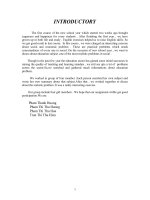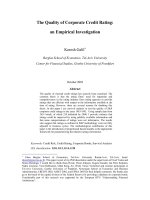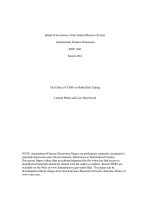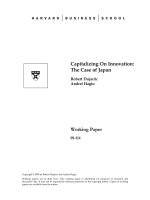24,185 OUTLETS - The number of JApAN pOST BANk outlets in Japan docx
Bạn đang xem bản rút gọn của tài liệu. Xem và tải ngay bản đầy đủ của tài liệu tại đây (767.88 KB, 8 trang )
JAPAN POST BANK Annual Report
To be “The Most Convenient and
Trustworthy Bank in Japan”
JAPAN POST BANK has continued to make consistent e orts to ful ll its mission of being
“the most convenient and trustworthy bank in Japan”. In today’s challenging market environ-
ment, JAPAN POST BANK is making the most of its strengths to ful ll that mission.
24,185
OUTLETS
The number of JAPAN POST
BANK outlets in Japan
Special Feature
JAPAN POST BANK Annual Report
Our Operating Environment
Special Feature
Japan’s retail nancial market has two distinctive features. First, the market
is extremely large; the total amount of individual nancial assets is said to
be the second largest in the world, approximately ¥, trillion. Second, in
comparison with other major countries, cash and deposits account for a
high proportion of individual nancial assets—more than %. Conse-
quently, Japan has the largest amount of cash and deposits in the world.
Until a few years ago, household assets in Japan had begun to shift from
savings to investments, and consequently the proportion of individual
nancial assets accounted for by risk assets, such as equities and investment
trusts, began to increase. However, against a background of uncertainty in
nancial markets from , consumers became more risk averse, and
deposits began to increase once again. In Japan, the ongoing trend toward
a declining birthrate and an aging population is making it increasingly dif-
cult to maintain the current public pension system; there is a steadily
growing recognition that individuals need to secure their own resources for
retirement. Deposits continued to be the primary method of saving per-
sonal wealth.
Sources: Bank of Japan “Flow of Funds”, FRB “Flow of Funds Account”, ONS “United Kingdom Economic Accounts”, Deutsche Bundesbank “Households’
nancial assets and liabilities -”, Banque de France “Financial Accounts”
Source: Bank of Japan “Flow of Funds”
Household Assets in Major Countries
Japan Germany United Kingdom France United States
100
75
50
25
0
%
Cash and deposits
Insurance and pension
Securities excluding stocks
Stocks and other equities
Others
Household Assets in Japan
2001 2002 2003 2004 2005 2006 2007 2008 2009 2010
1,600
0
800
400
1,200
¥ TRILLION
Cash and deposits
Bonds
Investment trusts
Stocks and other equities
Insurance and pension
Others
FISCAL YEAR
JAPAN POST BANK Annual Report
Bank agency operations through a massive
nationwide network of approximately ,
post o ces sta ed by approximately ,
post o ce employees
Leverage points of customer contact that
are closely linked to local communities, and
implement sales promotions
Draw on brand recognition cultivated over an
extensive history
•
•
•
The Distinctive Role of JAPAN POST BANK
The distinctive role of JAPAN POST BANK’s retail banking operations is
supported by three key strengths—the convenience that stems from the
Bank’s extensive network, the con dence derived from the Bank’s massive
deposit base, and the safety that results from the Bank’s conservative invest-
ment policies. With these three strengths, JAPAN POST BANK has a clear
competitive advantage over other nancial institutions.
JAPAN POST NETWORK is a reliable partner that is indispensable in the
conduct of the Bank’s operations. JAPAN POST BANK and JAPAN POST
NETWORK have been one operation for more than years, ever since the
Post O ce started postal savings and domestic remittance operations in
. Even after , when the Bank was spun o from JAPAN POST, the
Bank and JAPAN POST NETWORK have enjoyed a mutually bene cial rela-
tionship, with the Bank acting primarily as the planning division and JAPAN
POST NETWORK as the sales division.
The following pages illustrate the role the Bank is playing as it leverages
and builds on this relationship with JAPAN POST NETWORK.
Development of nancial products that meet
fundamental customer needs
Conservative investment of deposits
Implementation of sales promotions and
campaigns
Implementation of marketing education and
training for post o ce employees
•
•
•
•
Three distinct strengths supporting the signi cance of JAPAN POST BANK’s operations
Providing nancial services through the division of roles
The largest number of accounts
and the largest customer base
in Japan
Broad base of customers
extending to all generations
and all regions of Japan
•
•
COnVenI enCe
Steady, conservative investment
policy, centered on Japanese
Government Bonds
Maintenance of low-cost
operations
•
•
SAfeTY
COnfIdenCe
A network of outlets that is within
walking distance of nearly every
point in Japan, available through
JAPAN POST NETWORK
Comprehensive sales channels,
including branches, ATMs, and
the Internet
•
•
Hokkaido
Tohoku
Shikoku
Kinki
Chubu
Chugoku
Kyushu
Okinawa
Kanto
Japan
234 Branches
23,951 Post Oces
26,191 ATMs
5
1,480
1,677
10
2,572
2,278
111
4,995
6,981
33
4,468
4,532
44
6
1
201
249
3,411
1,154
4,065
1,154
11
2,235
2,167
13
3,435
3,088
(As of March 31, 2010)
Average
of Japan’s
Mega Banks
NUMBER OF
DOMESTIC OUTLETS*
1
(As of March 31, 2010)
JAPAN POST
BANK
Number of
Municipalities*
2
Total of
Six Major
City Banks
JAPAN POST
BANK
24,185
635
1,750
26,146
25,786
NUMBER OF
DOMESTIC CD ATMS
(As of September 30, 2009)
JAPAN POST BANK Annual Report
An Extensive Network
As of March , , the Bank had a total of , outlets nationwide,
comprising branches and , post o ces. In addition, the Bank had
, ATMs.
This outlet network is substantially broader than the domestic branch
networks of Japan’s mega banks, and the ATM network is signi cantly
larger than the ATM networks in convenience store chains. Underpinned by
this extensive network, JAPAN POST BANK has an extremely close and con-
venient presence for people living in all regions of Japan, and as a result the
Bank has become an integral part of their daily lives.
COnVenIenCeStrength
Special Feature
*. Outlets: Branches + Post o ces
*. Municipalities: All cities, towns, and villages in Japan
Sources: Japan Bankers Association and each Bank’s respective o cial web site
Local Authorities Systems Development Center (LASDEC) o cial web site
15JAPAN POST BANK Annual Report 2010
Outlets and Services
The Bank has two types of outlets: 234 branches, principally in urban areas,
and 23,951 post o ces that have been commissioned to handle bank
agency operations. Most branches are operated under the JAPAN POST
BANK name while being located in post o ce buildings, but some branch-
es are in buildings that are separate from post o ce facilities. At post of-
ces, which are operated by JAPAN POST NETWORK, employees handle
bank agency operations as one facet of counter operations.
The services o ered by outlets di er in accordance with the needs of the
customers in each area. For example, deposits and domestic remittance
services are o ered at nearly all outlets, including post o ces. However,
some post o ces do not handle sales of investment products, such as in-
vestment trusts, and mortgage loan intermediary operations are only avail-
able at certain branches.
Distinctive Features of Our ATM Service
To maintain existing customers and to cultivate new customers, we do not
charge a commission for the use of our ATMs with our bank cards, no matter
what time the ATM is used. We believe that this convenience is one of the
key reasons we have earned the support of so many customers.
In addition, customers from overseas can use our ATMs to withdraw
money. Almost all credit cards and bank cards issued by overseas nancial
institutions can be used to withdraw cash in yen.
The Bank’s ATMs are also easy to use for physically challenged customers.
Braille and voice guidance systems are available for visually challenged
customers. (These services are available in English as well as Japanese.)
Internet Banking
The Bank is continuously enhancing its service lineup. We o er Internet
banking services through the website “Yucho Direct”. In January 2009, we
began to participate in the Interbank Data Telecommunication System,
“Zengin Net”, and consequently transfers to and from other nancial institu-
tions have been available, even via the Internet, since May 2009.
Available Everywhere:
JAPAN POST BANK Services
Post o ces, which provide JAPAN POST BANK
services, have a presence that extends through-
out Japan. This includes regions in which the post
o ce is the only nearby nancial institution. For
people who live in these areas, JAPAN POST BANK
outlets are a community place.
Services O ered at Outlets
Basic Services
Deposits
Domestic remittance
ATM service
•
•
•
Enhanced
Services
International
remittance
Investment trusts
Variable annuities
Mortgage loan
intermediary
•
•
•
•
KAMIONGATA POST OFFICE ZENKOJI POST OFFICE
JAPAN POST BANK Annual Report 201016
The Largest Balance of Deposits in the World
The Bank has the largest amount of deposits in the world, even in comparison
with overseas banks, and is one of the world’s largest nancial institutions.
A Massive Amount of Deposits
Special Feature
Overwhelming Individual Financial Assets in Japan
As mentioned previously, Japan has the largest amount of savings in the
world, and with its deposits of about ¥175 trillion, the Bank has a share of
about 25% of Japan’s deposits. This is a dominant share that exceeds the
total deposit base for major city banks. The Bank has an extremely strong
operating base in Japan’s individual nancial asset market, which is the
second largest in the world.
Note: Japanese banks as of March 31, 2010, others as of December 31, 2009. Calculated based on foreign exchange rates as of the respective scal year-end.
Source: Corporate disclosures
Note: Individual deposits are the total for liquid deposits, time deposits, and negotiable certicates of deposit.
Sources: Bank of Japan “Flow of Funds”, The Japan Financial News Co., Ltd. “Nikkin Shiryo Nenpo 2009”
(As of March 31, 2008)
ConfidenCeStrength
Total Deposits of Major Banks Around the World
500 1,000 1,500 2,0000
JAPAN POST BANK
ICBC
Mitsubishi UFJ Financial Group
HSBC
China Construction Bank
RBS
JP Morgan Chase
BNP Paribas
Bank of China
Crédit Agricole
BOA
Barclays Bank
Citigroup
Wells Fargo & Company
Banco Santander SA
Mizuho Financial Group
ING
Sumitomo Mitsui Financial Group
Lloyds
Bank of Scotland
$ BILLION
Share of Individual Deposits in Japan
Individual deposits: ¥727.4 trillion
JAPAN POST BANK
Major city banks and trust banks
Regional banks
Credit unions and associations
Others
25.0%
23.1%
25.3%
15.5%
11.0%
JAPAN POST BANK Annual Report
Background to Massive Amount of Deposits
The Bank’s history is one of the reasons why it has been entrusted with this
massive amount of deposits. We have a track record in savings operations
that extends back more than years. Other reasons include our extensive
network, which gives us a close-by presence for customers throughout Japan.
For this reason, the Bank is known in Japan as “the people’s savings bank”.
Customers also trust the Bank because of its high capital adequacy ratio
and stable management. These factors are a direct result of our policy of
investing the savings deposited with us in low risk assets, such as Japanese
Government Bonds.
We also have a distinctive product, TEIGAKU deposits. With these depos
-
its, funds can be withdrawn at any time after six months from the inception
of the deposit. The interest rate on TEIGAKU deposits is higher than the rate
on ordinary deposits, and the interest rate at the point the deposit is made
can be applied for up to years. For the depositor, TEIGAKU deposits oer
liquidity and attractive interest rates. TEIGAKU deposits accounted for
.% of the Bank’s deposits as of March , . Consequently, xed-term
deposits accounted for an extremely high share of the Bank’s deposits.
Specically, as of March , , xed-term deposits accounted for .%
of the Bank’s deposits, compared with an average of .% for Japan’s mega
banks. At ¥. trillion, the Bank’s xed-term deposits were about three
times the average of ¥. trillion for Japan’s mega banks.
This dierence indicates the condence that our customers feel in de-
positing their savings for an extended period of time. TEIGAKU deposits
enable the Bank to secure stable funds for investment.
* Japan’s Mega Banks: Mitsubishi UFJ Financial Group ( banks), Sumitomo Mitsui Financial Group ( bank), and Mizuho Financial Group ( banks)
Source: Created from published materials from each company
(As of March , )
Liquid and Fixed-term Deposits
Average of
Japan’s Mega Banks
75,000
50,000
25,000
0
¥ BILLION
JAPAN POST
BANK
Liquid Deposits
Average of
Japan’s Mega Banks
120,000
80,000
40,000
0
¥ BILLION
JAPAN POST
BANK
Fixed-term Deposits
JAPAN POST BANK Annual Report 20101
Conservative Investment
Special Feature
From our very earliest days back in the 19th century, we have taken on the
responsibility of protecting a substantial portion of the nation’s assets as
“the people’s savings bank”. Accordingly, we have been called upon to
invest, in a conservative and low risk manner, the massive amount of funds
deposited with the Bank. Given the scale of our deposits, we have been
able to secure an adequate return on invested funds without pursuing a
high-risk, high-return investment policy.
As of March 31, 2010, securities accounted for 92.72% of investments, with
Japanese Government Bonds accounting for 1.10% of investments. Japa-
nese Government Bonds, which have zero credit risk and are free from
currency risk, bring us a xed return.
On the other hand, we recognize that we must diversify our investments
to reduce interest rate risk. We have increased our investment in instru-
ments other than Japanese Government Bonds in recent years. With careful
risk screening, we have invested in such instruments as Japanese local
government bonds, foreign bonds, and syndicated loan investments. Mov-
ing forward, as the “most trustworthy bank”, which has been entrusted with
a substantial share of the assets of Japan’s consumers, we will implement
safe investment practices while managing risk and work to generate steady
returns on investment.
SAfe TYStrength
Breakdown of Investments
Japanese Government Bonds (81%)
Japanese local government bonds (3%)
Commercial paper (0%)
Japanese corporate bonds (6%)
Foreign bonds (2%)
Investments in aliates (0%)
Other securities (1%)
Loans (2%)
Deposits (to the scal loan fund) (1%)
Others (4%)
81%
3%
6%
2%
0%
2%
1%
1%
4%









